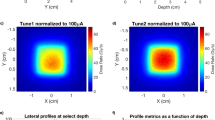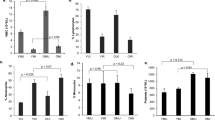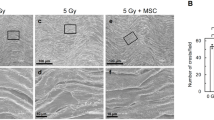Abstract
IT is known that the response of animals to whole-body X-irradiation in the lethal range can be modified by certain changes in their physiological state induced before exposure. For example, the administration of oestrogens1, bacterial endotoxin2, colchicine3, or urethane4 to mice 1 day or more before lethal irradiation results in a modest but definite increase in the number of animals surviving over a period of 30 days. The mechanism(s) by which these diverse agents enhance the radiation resistance of rodents is not clear; however, it can be stated that their protective effect must be mediated by way of modes of action different from those of the “classical” chemical radioprotectors such as cysteine, cysteamine or AET5, which are only effective when administered immediately before (about 30 min) irradiation.
This is a preview of subscription content, access via your institution
Access options
Subscribe to this journal
Receive 51 print issues and online access
$199.00 per year
only $3.90 per issue
Buy this article
- Purchase on SpringerLink
- Instant access to full article PDF
Prices may be subject to local taxes which are calculated during checkout
Similar content being viewed by others
References
Straube, R. L., Patt, H. M., Swift, M. N., Amer. J. Physiol., 155, 471 (1948).
Smith, W. W., Alderman, I. M., and Gillespie, R. F., Amer. J. Physiol., 191, 124 (1957).
Smith, W. W., Science, 127, 340 (1958).
Cole, L. J., and Gospe, S. R., Radiat. Res., 15, 684 (1961).
Bacq, Z. M., and Alexander, P., Fundamentals of Radiobiology, second ed. (Pergamon Press, New York, 1961).
Selye, H., The Physiology and Pathology and Exposure to Stress (Acta Inc., Montreal, 1950), supplements 1951 and 1952.
Betz, E. H., Contribution à l' Etude du Syndrome Endoerinien Provoque par l' Irradiation Totale de l' Organisme (Masson, Paris, 1956).
Doery, H. M., and Pearson, J. E., Biochem. J., 92, 599 (1964).
Barker, S. H., Bayyuk, S. I., Brimacombe, J. S., and Palmer, D. J., Nature, 199, 693 (1963).
Kreil, G., Monatsh. Chem., 96, 2061 (1965).
Haberman, E., and Reiz, K. G., Biochem. Z., 341, 451 (1965).
Bacq, Z. M., Chemical Protection Against Ionizing Radiation (Charles C. Thomas, Springfield, Ill., 1965).
Ortel, von S., and Markwardt, F., Pharmazie, 10, 743 (1955).
Author information
Authors and Affiliations
Rights and permissions
About this article
Cite this article
SHIPMAN, W., COLE, L. Increased Resistance of Mice to X-irradiation after the Injection of Bee Venom. Nature 215, 311–312 (1967). https://doi.org/10.1038/215311a0
Received:
Revised:
Issue date:
DOI: https://doi.org/10.1038/215311a0



